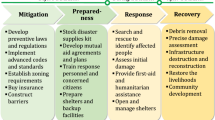Abstract
Neuronets are considered for processing data on the state of a potentially hazardous object after an emergency. An example is given of processing the data on the state of a potentially hazardous object in increments.
Similar content being viewed by others
REFERENCES
Neuron Nets [Russian translation], Goryachaya Liniya Telekom, Moscow (2001).
A. I. Galushkin, Neurocomputers and Their Applications. Volume 3. Neurocomputers [in Russian], IPRZhR, Moscow (2000).
A. N. Gorban’, Training Neuron Nets [in Russian], SP PapaGraf, Moscow (1991).
L. N. Bol’shev and N. V. Smirnov, Tables for Mathematical Statistics [in Russian], Nauka, Moscow (1965).
N. N. Evtikheev et al., “Mathematical models and optical realizations of multilayer and polynomial neuron nets,” Preprint No. 004-94 [in Russian], MIFI, Moscow (1994).
S. M. Ermakov, The Monte Carlo Method and Related Topics [in Russian], Nauka, Moscow (1971).
Additional information
Translated from Izmeritel’naya Tekhnika, No. 3, pp. 6–8, March, 2005.
Rights and permissions
About this article
Cite this article
Radaev, N.N., Daragan, A.D., Agapov, A.M. et al. Neuronet Data Processing on the State of an Object After an Emergency. Meas Tech 48, 211–214 (2005). https://doi.org/10.1007/s11018-005-0125-x
Received:
Issue Date:
DOI: https://doi.org/10.1007/s11018-005-0125-x




